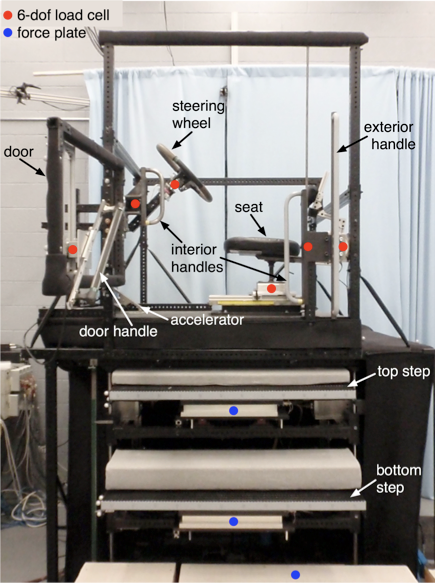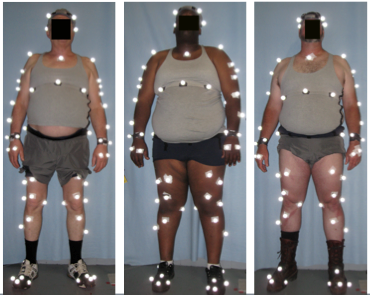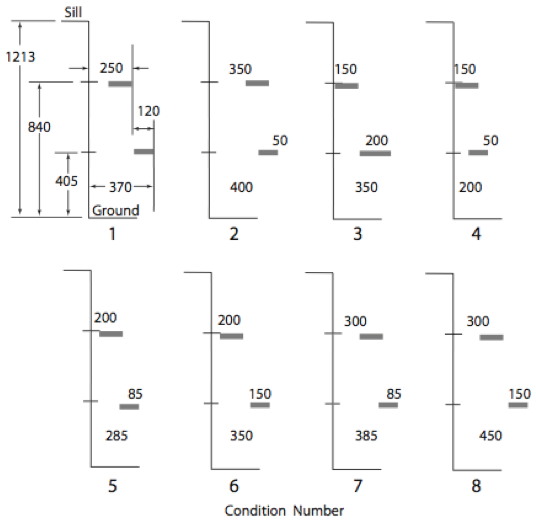Truck Ingress/Egress Research
Research at UMTRI
With support from the U.S. National Institute for Occupational Safety and Health (grant R01 OH009153) and contributions from the truck industry, UMTRI has conducted several large-scale studies of truck ingress/egress, including both field and laboratory research. The data from these studies is still being analyzed, but important results are already available and numerous publications have already appeared.
The sections below describe field studies characterizing the diversity of truck ingress/egress systems currently in use; quantifying step and handhold dimensions; and categorizing driver ingress/egress tactics. In laboratory studies, experienced truck drivers have been tested in a wide range and step and handhold configurations. A wide range of dependent measures have been examined, including movements, forces, and subjective responses.
Field Studies
Step and Handhold Configurations
Our investigators spent weeks visiting truck stops to document the range of step and handhold configurations currently in use on U.S. trucks. We focused on tractor-semitrailer cabs, but also looked at straight trucks. We developed a simple categorization that describes most of the steps and handholds currently in use. [More...]
Step and Handhold Dimensions
The standards and design guidelines for truck steps and handholds focus, for good reason, on the sizes and locations of the steps and handholds. We made extensive measurements of actual trucks to determine what ranges of dimensions were currently in use, and compared them to the standards. We found that trucks intended for similar purposes often had quite different step and handhold configurations, suggesting that at least some of them are not optimal. [More...]
Driver Behaviors
The most important factor affecting a drivers risk of injury in ingress/egress is behavior. We conducted several field studies to understand driver behavior. In the first study, we interviewed and video-recorded drivers to learn more about their experiences. Recognizing that drivers behave differently when they know they're being observed, we conducted another study using covert observation to document driver ingress/egress behaviors. Among the important findings: Drivers have all been taught to exit the cab facing inward, that is, toward the steps, but about half the time drivers face away from the vehicle when exiting.
Follow these links for details of the field investigations and findings:
Laboratory Studies
Field studies provide valuable data on truck designs and driver behaviors, but lab studies allow much more detailed measurement of driver interactions with the steps and handholds. We conducted a two-phase laboratory study with 60 experienced truck drivers using a laboratory mockup of a truck cab that could be quickly adjusted to represent a wide range of step and handhold configurations. The motions of the drivers were recorded as they climbed in and out of the mockup, and forces on the ground, steps, and handholds were recorded. The data provide a rich source of information on what really happens when drivers get into and out of trucks.
Laboratory Mockup
The figure shows the UMTRI truck ingress/egress mockup, which was based on analysis of the dimensions of dozens of trucks. The two steps can be moved in and out and up and down. Each step is mounted on a force plate that records forces and moments on three axes. The steering wheel, handholds on the door, and handholds aft of the door opening are mounted on load cells to record hand forces.

Motion Capture
The motions of the drivers were recorded using a passive optical motion capture system from VICON. This type of technology is widely used to record the movements used to drive computer-generated characters in video games and feature films. In our laboratory, the data are used to conduct biomechanical analyses of the drivers' movements. Combined with the force data from the steps and handholds, the forces and torques on the drivers' joints can be analyzed to assess how changing the step and handhold configurations affect the stresses on drivers' bodies. The image shows several subjects with the optical markers.

Participants
Sixty experienced truck drivers participated in the laboratory studies. All drivers had at least five years of experience and had driven professionally in the past two years. Drivers ranged in age from 24 to 67 years (median 49 years), and about half of the drivers were obese (body mass index ≥ 30 kg/m2). Eleven of the drivers (18%) were women, representing an oversampling of about 3X (approximately 5% of U.S. truck drivers are women).
A range of step and handhold conditions were tested, spanning most of the configurations currently in use on U.S. trucks. Drivers entered and exited the mockup using both self-selected and prescribed tactics (for example, facing inward or facing outward). Motion and force data were recorded for all trials, and drivers provided subjective evaluation of the ease of getting into and out of the simulated cab. Additional tests included measures of driver balance capability and driver preferences for step heights.

Findings
Analysis of the data from the lab studies is ongoing, but a range of important results have been reported already. Follow the links below for details:
- Driver hand grasp locations for ingress are not strongly related to body size
- Right hand forces during ingress are affected by step configuration
- Driver preference for first-step height is not strongly related to body dimensions
- Drivers prefer step configurations with larger horizontal offsets
- Driver foot motions follow consistent patterns during ingress
- Ground reaction forces are strongly influenced by body mass index and egress tactic
- IE dynamics can be analyzed using the AnyBody musculoskeletal model
©2017 University of Michigan